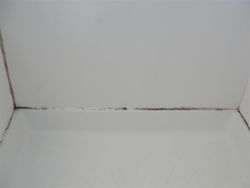Dirty bathrooms are a huge turnoff for home buyers. Mold is another huge turnoff. Combine the two and the 'yuck' factor multiplies. I think everyone has seen moldy bathroom caulk before, and if you've tried cleaning this stuff, you know it's impossible.
I recently moved in to home with some nasty looking caulk in the shower; that's my shower pictured above. I figured I would need to remove all of the moldy caulking and re-caulk my shower walls to get them looking good again, but after doing some online research, I found a cleaning method that worked surprisingly well and wasn't much work. Don't worry, I'm not going to turn this in to a Martha Stewart blog… but I was so happy with the results that I had to share the process.
Gather supplies. I grabbed a small mixing bowl, a jug of bleach, a box of baking soda, a disposable paint brush, a roll of plastic wrap, and a spray bottle. The plastic wrap (orange handle, green plastic) shown in the photo below is the stuff you use to wrap things together, but you can also use the same plastic wrap you keep in your kitchen. Oh, and one other thing – while it's not required for the project, I strongly suggest wearing a respirator. Those bleach fumes are bad news. Also, wear old clothes that you wouldn't mind spilling bleach on. It might happen.
Mix up your cleaning solution. The cleaning solution consists of a bleach and baking soda paste. You make it by mixing bleach and baking soda in a bowl until it's about the consistency of pancake batter. The baking soda doesn't do any cleaning; it's just a cheap powder that will help make the bleach pasty. Don't skimp on the cleaning solution here – go ahead and make way more than you think you'll need. Bleach and baking soda are both inexpensive.
 Apply the cleaning solution to the moldy caulk. Use your disposable paint brush to apply the bleach paste on to the moldy caulk. Again, don't skimp here; it's cheap, so cake it on. I suggest you try to work somewhat quickly though. The bleach is going to disintegrate the bristles on your disposable paint brush, so you don't have all day.
Apply the cleaning solution to the moldy caulk. Use your disposable paint brush to apply the bleach paste on to the moldy caulk. Again, don't skimp here; it's cheap, so cake it on. I suggest you try to work somewhat quickly though. The bleach is going to disintegrate the bristles on your disposable paint brush, so you don't have all day.
Cover the cleaning solution with plastic and wait. Covering the cleaning solution with plastic will help to keep the bleach from drying out. Now you wait. If you have a white porcelain kitchen sink or white porcelain whatever-else, spread the extra cleaning paste on it. You can just let the paste sit for about 10 minutes, and then your sink will look brand new when you rinse the bleach off. No scrubbing required.
Check on it. After the bleach has been sitting for several hours, it will probably have dried out, despite the plastic covering. At this point, if the caulking looks as good as new, great! You're done. If you still have moldy caulk, put some bleach in a spray bottle and wet the walls down right above the plastic wrap. The bleach will run down underneath the plastic and re-saturate the paste. You can do this as many times as it takes, but even with my super-nasty caulk, I only needed to re-apply the bleach one time.
Now clean up. At this point, your caulk should look brand new and bleachy fresh, or at least pretty close to it. Now you can clean up the mess. Water works just fine. Click on the before and after photos below for a larger version to see how well this worked. If I were a better photographer, all of the whites would have looked the same, but oh well… I think you get the point.
I was amazed that this worked so well. The entire project probably involved about 20 minutes of work, and required no elbow grease whatsoever.
And now, a word of caution: do this project at your own risk. Bleach is powerful stuff. Read the warning label on the bleach. It says to use in a well-ventilated area, don't let it touch your skin, don't breath the vapors, etc. Bleach can also cause pits in metal. I used it on the metal trim ring for my shower faucet and no pitting occured, but other people might not be so lucky. Also, I'm not kidding about wearing a respirator.
Reuben Saltzman, Structure Tech Home Inspections - Email- Minnesota Home Inspections








